Introduction
Chickpea curry is a beloved dish that has captured the hearts and taste buds of food enthusiasts worldwide. Known for its rich flavors, aromatic spices, and hearty texture, this dish not only satisfies hunger but also provides an array of nutritional benefits. Whether you’re a seasoned cook or a kitchen novice, chickpea curry is an excellent option to add to your culinary repertoire. This article will guide you through the ingredients, preparation, and serving suggestions for making this delightful dish.
Ingredients
To create a flavorful chickpea curry, you’ll need the following ingredients:
- 2 cups of chickpeas (canned or soaked overnight if using dried)
- 1 tablespoon of olive oil or any cooking oil of your choice
- 1 large onion, finely chopped
- 3 cloves of garlic, minced
- 1-inch piece of ginger, grated
- 2 tomatoes, pureed
- 1 teaspoon of cumin seeds
- 1 teaspoon of turmeric powder
- 1 teaspoon of coriander powder
- 1 teaspoon of garam masala
- 1 teaspoon of red chili powder (adjust to taste)
- 1 can (400 ml) of coconut milk or 1 cup of plain yogurt
- Salt to taste
- Fresh cilantro leaves, chopped (for garnish)
- 1 tablespoon of lemon juice (optional)
Instructions
Follow these step-by-step instructions to prepare your chickpea curry:
- Prepare the Chickpeas:
- If using canned chickpeas, drain and rinse them thoroughly.
- If using dried chickpeas, soak them overnight in water. Drain and rinse before cooking.
- Heat the Oil:
- In a large pan, heat the olive oil over medium heat.
- Sauté the Aromatics:
- Add cumin seeds to the hot oil and let them splutter.
- Add the chopped onion and sauté until golden brown.
- Stir in the minced garlic and grated ginger, cooking for another 2 minutes until fragrant.
- Add the Tomatoes:
- Pour the tomato puree into the pan and cook for about 5 minutes, stirring occasionally, until the mixture thickens and the oil starts to separate.
- Spice It Up:
- Mix in the turmeric, coriander, garam masala, and red chili powder. Cook for another 2 minutes to enhance the flavors.
- Incorporate the Chickpeas:
- Add the chickpeas to the pan, stirring well to coat them with the spice mixture.
- Simmer the Curry:
- Pour in the coconut milk or yogurt, stirring to combine. Bring the mixture to a gentle boil, then reduce the heat and let it simmer for about 15-20 minutes. Stir occasionally to prevent sticking.
- Season and Finish:
- Add salt to taste. If desired, stir in the lemon juice for a hint of tanginess.
- Garnish with fresh cilantro before serving.
Nutrition Facts
Chickpea curry is not only delicious but also packed with nutrients. Here’s a breakdown of what you can expect in a typical serving:
- Calories: Approximately 350-400 per serving
- Protein: 12-15 grams
- Carbohydrates: 45-50 grams
- Fiber: 10-12 grams
- Fat: 15-20 grams (depending on the use of coconut milk)
- Vitamins and Minerals: Rich in iron, magnesium, potassium, and vitamin C
Chickpeas are a great source of plant-based protein and fiber, making this dish particularly satisfying and nutritious.
How to Serve
Chickpea curry is a wonderfully versatile dish that not only delights the palate but also lends itself to various serving styles, making it suitable for any occasion or dietary preference. Here are some detailed serving suggestions that enhance the experience of enjoying chickpea curry:
With Rice
One of the most traditional and popular ways to serve chickpea curry is over a bed of rice. The fragrant grains of steamed basmati or jasmine rice provide a perfect canvas for the rich, spiced sauce of the curry.
- Basmati Rice: Known for its long, fluffy grains and aromatic qualities, basmati rice pairs beautifully with chickpea curry. To prepare, rinse the rice thoroughly to remove excess starch, then cook it in water with a pinch of salt and a few cardamom pods for added flavor.
- Jasmine Rice: This slightly stickier rice variety complements the curry’s flavors well. For a more aromatic touch, consider adding a splash of coconut milk during cooking.
- Quinoa: For a nutritious twist, serve the curry over quinoa. This protein-packed grain not only adds a nutty flavor but also enhances the dish’s health benefits.
- Coconut Rice: For those seeking an extra layer of flavor, try making coconut rice by cooking jasmine rice with coconut milk, water, and a pinch of salt. The creamy texture and subtle sweetness of coconut rice elevate the dish even further.
With Bread
Chickpea curry is also delightful when paired with various types of bread, which can be used to scoop up the curry and soak up its rich sauce.
- Naan: This soft, pillowy Indian bread is a classic accompaniment. You can find it in various flavors, such as garlic or butter naan, or opt for whole wheat versions for a healthier choice. Warm the naan in the oven or on a skillet before serving to enhance its texture.
- Roti or Chapati: These unleavened flatbreads are excellent for those looking for a lighter option. They are easy to make at home and can be enjoyed fresh off the skillet, providing a slightly chewy texture that complements the curry perfectly.
- Pita Bread: The pocket-like structure of pita makes it a fun alternative for serving chickpea curry. Cut the pita into halves or quarters, warm them up, and fill them with chickpea curry for a delightful handheld meal.
- Garlic Bread or Focaccia: For a unique twist, try serving chickpea curry with garlic bread or focaccia. The herbaceous and buttery flavors of the bread add a new dimension to the meal.
As a Soup
Transforming chickpea curry into a soup is an excellent way to enjoy it, especially on a chilly day. By adding more liquid, you can create a comforting and nourishing bowl of soup.
- Coconut Milk: Incorporate additional coconut milk to enhance the creaminess and richness of the dish. This not only adds flavor but also contributes to a velvety texture.
- Vegetable Broth: For a lighter option, substitute coconut milk with vegetable broth. This will maintain the flavor while making the dish less heavy.
- Additional Vegetables: Consider adding chopped vegetables such as spinach, kale, or carrots for added nutrition and texture. They will cook quickly in the soup, adding color and flavor.
- Serve with Crusty Bread: When serving as a soup, accompany it with a slice of crusty bread or a warm roll for dipping, creating a satisfying and hearty meal.
As a Topping
Chickpea curry can also be utilized as a topping, adding flavor and nutrition to various base ingredients.
- Baked Potatoes: For a comforting and filling meal, top a baked potato with chickpea curry. The creamy potato flesh acts as a perfect canvas for the robust flavors of the curry. For added richness, consider adding a dollop of sour cream or a sprinkle of cheese.
- Roasted Vegetables: Drizzle chickpea curry over a medley of roasted vegetables like sweet potatoes, bell peppers, and zucchini for a colorful and nutrient-dense dish. The sweetness of the roasted vegetables pairs beautifully with the spiciness of the curry.
- Salads: Use chickpea curry as a protein-rich topping for salads. It can add warmth and substance to a bed of mixed greens, cucumbers, and cherry tomatoes. Consider a drizzle of yogurt or tahini dressing to tie the flavors together.
- Grain Bowls: Create a nourishing grain bowl by serving chickpea curry over a base of farro, barley, or brown rice, and top with fresh herbs, diced avocado, or a squeeze of lime for a refreshing finish.
Conclusion
Chickpea curry is not only versatile in its preparation but also in its presentation. Whether served with rice, bread, transformed into a soup, or as a topping, it offers numerous possibilities that cater to different tastes and occasions. By exploring these serving suggestions, you can elevate your chickpea curry experience, making it a delightful and satisfying meal every time.
Additional Tips
To elevate your chickpea curry to new heights, consider implementing the following comprehensive tips that will enrich both the flavor and nutritional value of your dish:
Experiment with Spices
Spices are the heart of any great curry, and chickpea curry is no exception. While the foundational spices like cumin and coriander are essential, don’t hesitate to explore beyond the basics:
- Spice Customization: Tailor the spice levels to suit your palate. If you enjoy heat, consider adding cayenne pepper or red chili flakes. Conversely, if you prefer a milder flavor, reduce the quantity of these spices or omit them altogether.
- Layering Flavors: Introduce additional spices like cardamom, which adds a sweet, floral note, or cinnamon, which can lend warmth and complexity. A pinch of nutmeg can also enhance the dish’s richness.
- Fresh vs. Dried: Whenever possible, use freshly ground spices rather than pre-ground ones. Freshly ground spices have a more vibrant flavor and aroma, making a noticeable difference in your curry.
Add Vegetables
Incorporating a variety of vegetables into your chickpea curry not only boosts its nutritional profile but also adds texture and flavor:
- Leafy Greens: Spinach or kale can be added during the last few minutes of cooking. They wilt quickly and contribute a rich, earthy flavor along with essential vitamins and minerals.
- Colorful Additions: Bell peppers not only introduce a pop of color but also a sweet crunch. Choose red, yellow, or orange peppers for a sweeter taste, or stick with green for a more bitter note.
- Root Vegetables: Sweet potatoes or carrots can be diced and added to the curry for a touch of sweetness and an extra layer of heartiness. They pair beautifully with the spices and provide a satisfying contrast to the chickpeas.
- Seasonal Vegetables: Don’t hesitate to incorporate seasonal produce. Zucchini, cauliflower, or even squash can complement the dish and make it more versatile throughout the year.
Use Fresh Ingredients
The quality of your ingredients can make a significant difference in the taste of your chickpea curry:
- Fresh Herbs: Garnish your curry with fresh herbs like cilantro or parsley just before serving. These herbs add a burst of freshness that can brighten the entire dish.
- Ripe Tomatoes: If using tomatoes, opt for ripe, juicy ones for a rich base. You can also use canned tomatoes or tomato puree, but ensure they are of high quality. Fresh tomatoes will contribute acidity and sweetness, balancing the spices.
- Coconut Milk: If your recipe calls for coconut milk, choose a high-quality brand or, even better, fresh coconut milk. The richness of coconut milk can complement the spices and create a creamy texture.
Make It Ahead
Chickpea curry is one of those dishes that truly benefits from time. When you prepare it in advance, the flavors have time to meld and deepen, resulting in an even more delicious meal:
- Batch Cooking: Consider making a large batch of chickpea curry, especially if you’re hosting a gathering or meal prepping for the week. The flavors develop beautifully overnight, making it an ideal option for meal prep.
- Storage Tips: Store leftovers in an airtight container in the refrigerator for up to three days. You can also freeze portions for longer storage—just make sure to cool the curry completely before transferring it to freezer-safe containers. It can last up to three months in the freezer.
- Reheating: When reheating, add a splash of water or coconut milk to prevent the curry from drying out. Gently heat it on the stove or in the microwave, stirring occasionally to ensure even warming.
- Serving Suggestions: Chickpea curry is versatile in its serving options. Pair it with basmati rice, quinoa, or whole grain naan for a complete meal. You can also serve it over a bed of greens for a lighter option.
Implementing these tips will not only enhance your chickpea curry experience but will also encourage you to get creative in the kitchen, making the cooking process enjoyable and rewarding.
FAQs
Is Chickpea Curry Vegan?
Yes, chickpea curry can be made vegan by using coconut milk instead of yogurt and ensuring all other ingredients are plant-based.
Can I Freeze Chickpea Curry?
Absolutely! Allow the curry to cool completely, then store it in an airtight container in the freezer for up to three months. Thaw overnight in the refrigerator before reheating.
How Can I Make Chickpea Curry Spicier?
To increase the heat, add extra red chili powder or fresh chopped chilies. Remember to adjust gradually and taste as you go.
What Can I Substitute for Coconut Milk?
You can use almond milk, soy milk, or cashew cream as alternatives to coconut milk. Keep in mind that this might alter the flavor and texture slightly.
Conclusion
Chickpea curry is a delightful dish that blends rich flavors with nutritional benefits. Its versatility allows it to pair well with various accompaniments, making it a perfect choice for any meal. With this guide, you can easily create a delicious chickpea curry to enjoy with family and friends. Experiment with the flavors, adjust the spices to your liking, and savor the warmth and comfort of this wonderful dish. Whether you’re a vegan, vegetarian, or simply a curry lover, chickpea curry is sure to become a staple in your kitchen.
Print
Chickpea Curry Recipe
Ingredients
-
- 2 cups of chickpeas (canned or soaked overnight if using dried)
-
- 1 tablespoon of olive oil or any cooking oil of your choice
-
- 1 large onion, finely chopped
-
- 3 cloves of garlic, minced
-
- 1-inch piece of ginger, grated
-
- 2 tomatoes, pureed
-
- 1 teaspoon of cumin seeds
-
- 1 teaspoon of turmeric powder
-
- 1 teaspoon of coriander powder
-
- 1 teaspoon of garam masala
-
- 1 teaspoon of red chili powder (adjust to taste)
-
- 1 can (400 ml) of coconut milk or 1 cup of plain yogurt
-
- Salt to taste
-
- Fresh cilantro leaves, chopped (for garnish)
-
- 1 tablespoon of lemon juice (optional)
Instructions
-
- Prepare the Chickpeas:
-
- If using canned chickpeas, drain and rinse them thoroughly.
-
- If using dried chickpeas, soak them overnight in water. Drain and rinse before cooking.
-
- Prepare the Chickpeas:
-
- Heat the Oil:
-
- In a large pan, heat the olive oil over medium heat.
-
- Heat the Oil:
-
- Sauté the Aromatics:
-
- Add cumin seeds to the hot oil and let them splutter.
-
- Add the chopped onion and sauté until golden brown.
-
- Stir in the minced garlic and grated ginger, cooking for another 2 minutes until fragrant.
-
- Sauté the Aromatics:
-
- Add the Tomatoes:
-
- Pour the tomato puree into the pan and cook for about 5 minutes, stirring occasionally, until the mixture thickens and the oil starts to separate.
-
- Add the Tomatoes:
-
- Spice It Up:
-
- Mix in the turmeric, coriander, garam masala, and red chili powder. Cook for another 2 minutes to enhance the flavors.
-
- Spice It Up:
-
- Incorporate the Chickpeas:
-
- Add the chickpeas to the pan, stirring well to coat them with the spice mixture.
-
- Incorporate the Chickpeas:
-
- Simmer the Curry:
-
- Pour in the coconut milk or yogurt, stirring to combine. Bring the mixture to a gentle boil, then reduce the heat and let it simmer for about 15-20 minutes. Stir occasionally to prevent sticking.
-
- Simmer the Curry:
-
- Season and Finish:
-
- Add salt to taste. If desired, stir in the lemon juice for a hint of tanginess.
-
- Garnish with fresh cilantro before serving.
-
- Season and Finish:
Nutrition
- Serving Size: one normal portion
- Calories: 400 per serving
- Fat: 20 grams
- Carbohydrates: 50 grams
- Fiber: 12 grams
- Protein: 15 grams





